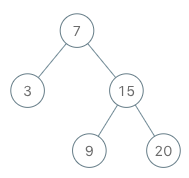实现一个二叉搜索树迭代器。你将使用二叉搜索树的根节点初始化迭代器。
调用 next() 将返回二叉搜索树中的下一个最小的数。
示例:

BSTIterator iterator = new BSTIterator(root); iterator.next(); // 返回 3 iterator.next(); // 返回 7 iterator.hasNext(); // 返回 true iterator.next(); // 返回 9 iterator.hasNext(); // 返回 true iterator.next(); // 返回 15 iterator.hasNext(); // 返回 true iterator.next(); // 返回 20 iterator.hasNext(); // 返回 false
提示:
next()和hasNext()操作的时间复杂度是 O(1),并使用 O(h) 内存,其中 h 是树的高度。- 你可以假设
next()调用总是有效的,也就是说,当调用next()时,BST 中至少存在一个下一个最小的数。
C#代码
/**
* Definition for a binary tree node.
* public class TreeNode {
* public int val;
* public TreeNode left;
* public TreeNode right;
* public TreeNode(int x) { val = x; }
* }
*/
public class BSTIterator {
TreeNode node;
IList<int> list = new List<int>();
int index = 0;
public BSTIterator(TreeNode root) {
node = root;
list = InorderTraversal(node);
}
/** @return the next smallest number */
public int Next() {
return list[index++];
}
/** @return whether we have a next smallest number */
public bool HasNext() {
return index < list.Count;
}
public IList<int> InorderTraversal(TreeNode root) {
var list = new List<int>();
if (root == null) return list;
var stack = new Stack<TreeNode>();
while (root != null || stack.Count > 0){
/*指针root指向二叉树入栈,入栈后指针指向入栈二叉树的左子树*/
while(root != null){
stack.Push(root);
root = root.left;
}
/*出栈,并将指针root指向出栈二叉树的右子树*/
root = stack.Pop();
list.Add(root.val);
root = root.right;
}
return list;
}
}
/**
* Your BSTIterator object will be instantiated and called as such:
* BSTIterator obj = new BSTIterator(root);
* int param_1 = obj.Next();
* bool param_2 = obj.HasNext();
*/